As a startup grows, it reaches a point where its sales efforts become inconsistent, creating challenges.
Take sales messaging, for instance.
Your team of salespeople pitching to a prospect with varying pitches. Not only does it create a disconnected buying experience, but it also erodes the prospect’s trust in sales, wrecking your business revenue in the long run.
Fortunately, the right sales battle cards can turn your sales performance around.
In this guide, we’ll walk you through how to create a sales battle card to standardize your messaging and convince prospective customers that your product is the better option.
What are Sales Battle Cards?
Sales battle cards are internal documents containing vital information about a company, like the product’s key features, the company’s differentiators, and pre-written responses to overcome potential customer objections.

Sales battle cards are created by the go-to-market (GTM) team.
Often used by sales teams, these internal documents are sales enablement resources that win competitive deals in every stage of the sales cycle.
What is the Purpose of a Battlecard?
To help the sales team back up their sales pitch with proof points that their product is the superior option.
Sales battle cards turn leads into customers, so much so that 71% of businesses improved their win rates after using them.

How Do You Make a Sales Battle Card?
An effective sales battle card prepares sales reps for the toughest pitches and enables the entire sales organization. Follow these six steps to create it.
1. Gather your go-to-market team
The best time to build a sales battle card is when you start encountering different types of competitors, like when prospects bring up your rivals in demo calls.
Assign your GTM team to implement this initiative.
Recap: A GTM team consists of team members launching a product to market. It includes every revenue-focused department (e.g., sales department, marketing team).
Ensure that everyone on this cross-functional team is on the same page.

For starters, the marketing, sales, and customer success teams should work closely together to collect customer feedback and get aligned with their target audience.
The outcome of this initiative depends on multiple factors, like your customer segment.
The problem?
Many organizations waste time on low-value customers.
And the numbers are staggering.
78.5% of sales professionals think inefficient lead qualification is the biggest challenge in the top-of-the-funnel sales process.
And the repercussions are excruciating.
According to Upland Altify, chasing wrong deals is costing every individual sales rep $218,000 per year. For a modest startup with five reps, that’s a potential annual loss of $1,090,000!
Fortunately, there’s a way to prevent this cost of lost pursuit—and it’s validating your ideal customer profile (ICP) using Breadcrumbs Reveal.
With our tool, you can analyze your marketing, sales, and product data in one central place and highlight the attributes and actions that accelerate revenue.
Here’s how it works:
- Connect your data sources with Breadcrumbs Reveal
- Define your success criteria (e.g., all paying customers on Pro plan)
- Run the analysis
Sit back and wait for the tool to unearth insights about your most valuable customers today. Note the analysis below. It shows you the most profitable industries you should focus on closing.

Reveal also highlights the actions customers perform the most on your website (and product). That way, you have a better understanding of the specific actions that indicate buying intent.
Grab your free account to validate your ICP today.
2. Decide which sales battle cards you need
47% of businesses maintain over 50 sales battle cards, proving different messages resonate with different customers.
“Not all battle cards are the same,” shares Akshaya Chandramouli, brand and content marketer at Storylane. “They should be made contextual according to the situation.”
Here are four popular examples to illustrate what we mean.
(i) Use case sales battle cards
The use case battle card showcases how a product works in a specific scenario or industry.
Imagine a digital asset management company that sells to manufacturers and retailers.
Both industries will require different use cases.
The manufacturing sector likely needs a solution for complex product portfolios (use case #1) and different routes-to-market (use case #2). Whereas the retail industry will want a centralized platform to manage brand assets for fast speed to market (use case #3).
(ii) Product sales battle cards
The product overview battle card highlights the product’s features and benefits and information about the prospect’s challenges and desires.
For this battle card, use the jobs-to-be-done framework as a starting point.
(iii) Unique selling proposition sales battle cards
The unique selling proposition (USP) or value proposition battle card outlines why a prospect should choose the product, focusing on its unique features.
Using Ahrefs as an example, the USP would be its largest database of US search queries and backlink index that gets updated every 15 minutes.
(iv) Competitor sales battle cards
The competitor overview battle card stacks up your product against your biggest competitors. It often includes responses to bypass customer objections (e.g., “[Competitor B] has a feature that your product doesn’t offer. Why should I choose you?”).
This card is likely to be used the most in your pitches, so let’s make it our main focus.

The two keys to creating an effective competitive sales battle card?
Demonstrating honesty about your competitors’ strengths.
And avoiding putting them down.
It’s tempting to over-crowd your sales battle card with their weaknesses.
However, prospects will inevitably bring up a competitor’s strength and throw you off your game, warns Joe Aicher.
“You want to be prepared,” adds the director of RevOps solutions at Breadcrumbs.
“Being honest and acknowledging your weaknesses can actually help you gain credibility as someone who knows what they’re talking about.”
The statistics certainly proved it: 85% of consumers shared they are more likely to support companies they consider honest.

So where to go from here?
What you want to do is pivot to a unique differentiator.
Let’s unpack how this looks like in the next step.
3. Hit the books
Sales battle cards are a resource, not a crutch.
Unfortunately, too many people dump one feature after the other in these sales documents.
A better approach, according to Amy Beaudoin, product marketing director at Visier, is to gather competitive intelligence beyond functionality.
Consider pitching your product vision, implementation cycle (i.e. time to value), or overall customer experience.
You could even talk about the competitor’s company itself.
“How viable is the organization? Are they looking at possibly being acquired? So, is there going to be a lot of disruption at that organization where it might be difficult to get help, etc., during a period of time?”
Amy Beaudoin, product marketing director at Visier
Beaudoin recommends hiring a third-party company for the competitive intelligence program. This company will interview customers on the buying and post-purchase experience.
And while you’re at it, evaluate your competitors’ packaging, pricing, overall messaging, positioning, and GTM approach.
“Competitive intelligence is really knowing how good your business is versus the competition,” shares Beaudoin.
“It’s not down to this functionality feature-by-feature comparison, but really understanding that you are the leader in the market and convincing your customers of that through these other ways of talking about the full experience that they’re going to have with you.”
If you’re conducting the interviews in-house, consider these questions in your list:
- “What part of [software] do you like the most? Why?”
- “How do you use [software]? Walk me through the process.”
- “What part of [software] do you not like?”
- “What [features] do you use the least / most often?”
- “Will you recommend [software] to your colleagues and friends? If yes, what features will you share?”
These responses shape the proof points of your sales battle cards, particularly those centered on product and value props.
Interview your most profitable customers for best results. If you’re unsure who these people are, approach the sales or customer success team.
Alternatively, use our contact scoring tool to identify them with zero guesswork.
- Connect your data source with Breadcrumbs
- Determine what actions make a profitable customer in the Activity model (e.g., logins every day, subscribes to Pro plan)
- Input the scoring threshold to be considered A1 (e.g., 80)
- Set the scoring model live
Our contact scoring tool will send all scoring information back to your main data source, notifying you when a customer hits your predefined scoring threshold.

This surfaces your best clients today instead of random users that may not convert to customers.
Start your free Breadcrumbs account today.
4. Stay consistent
A strong brand consistency impacts every stage in the buying experience, so much so that over 60% of companies believe it plays a vital role in lead generation and customer communication.
In the long term, it could even increase revenue by up to 20%.

This study from Lucidpress shows messaging needs to be consistent throughout the buying journey. In other words, every sales representative must quote the content in the sales battle cards verbatim.
“Sales battle cards aren’t scripts,” says Daivat Dholakia, a product manager at Salesforce.
“But every word should still count. If a customer speaks to several sales reps, they should receive similar messaging about your benefits relative to those of competitors.”
The messaging consistency in your battle cards will eventually reinforce your product’s positioning and why it’s the better choice.
5. Make them accessible
Companies that responded to customers within an hour of receiving their query were nearly seven times more likely to have a meaningful conversation with a key decision-maker.
However, sales reps are spending far too much time on manual tasks—like searching for the right sales battle cards—which slow down speed to lead.
Chandramouli reveals to Breadcrumbs, “Teams will invest hours creating their sales battle cards, but they underestimate the visibility, which ends up frustrating the sales team.”
Store your cards in a central sales content management platform that integrates with your existing data sources.

Categorize them in collections and tags (e.g., use case, buyer persona) so that sales reps can access them with a few quick clicks. Add color codes and headers to increase discoverability.
Also, make sure it’s easy for the sales team to share their feedback in real-time. Since your reps interact with clients the most, they will have the most valuable insights into how the battle cards perform.
6. Measure and update your sales battle cards
Sales battle cards are just like any other piece of content.
They’re never one and done.
These internal sales documents need to be updated according to changing market conditions, evolving customer needs, and unexpected trends.
“Reps should have access to battle cards frequently revised to match your active customers,” weighs in Tom Winter, co-founder of DevSkiller.
“The biggest mistake is to keep the same stale battle cards for years, which some companies do! This renders them pretty much useless.”
Update your sales battle cards on a monthly or weekly basis.
Better yet, measure the performance of your cards on a competitive intelligence platform and adjust them as needed. For example, if the overall win rate has decreased since launching the battle cards, gather feedback from the sales team and work together on improving them together.

Metrics like card usage, win rate, and competitive win rate will help you gauge performance and make the most of the battle cards.
Create Your Sales Battle Cards to Improve Your Win Rate Today
Not only do sales battle cards standardize your sales messaging, but they also arm your sales team with important information they can access anytime, anywhere.
With these ironclad proof points, they’ll never get caught off guard.
The first step is the most important.
Before you create these internal documents, see to it you’re targeting the right customers.
One way to validate your ideal customer profile (ICP) is to use Breadcrumbs Reveal. Analyze your existing marketing, sales, and product data to identify your most profitable customers today.
-
12 Useful Sales Tips For Overcoming Customer Objections
Read more: 12 Useful Sales Tips For Overcoming Customer ObjectionsIt may be a hard truth but rejection is inevitable when it comes to sales.…
FAQs
1. What are the elements of a sales battle card template?
It depends on the type of sales battle card you’re creating.
In most cases, the elements include an overview of the competing company, its products and pricing plans, strengths and weaknesses, and why the prospective client should pick your product instead.
2. What are the best practices for sales battle cards?
In a nutshell:
- Gather input from your from the GTM team
- Conduct customer research to validate what you’ve learned
- Keep your messaging clear, concise, and consistent
- Back up claims with ironclad proof
- Stay transparent (even when confronted about your product’s weaknesses)
- Update them on a monthly or weekly basis
3. Why do sales teams need battle cards?
Sales professionals use battle cards when pitching to prospects and customers with cross- and upsell potential. These sales internal documents back up their pitches with proof points that the product is the superior option.



